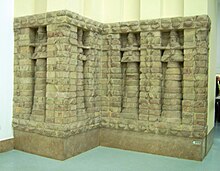Karaindash
| Karaindaš | |
|---|---|
| King of Babylon | |

Molded baked-brick bas-relief of the temple of Karaindaš from Uruk
|
|
| Reign | ca. 1410 BC |
| Predecessor | Agum III ? |
| Successor | Kadašman-Ḫarbe I |
| House | Kassite |
Karaindaš was one of the more prominent rulers of the Kassite dynasty and reigned towards the end of the 15th century, BC. An inscription on a tablet detailing building work calls him “Mighty King, King of Babylonia, King of Sumer and Akkad, King of the Kassites, King of Karduniaš,” inscribed ka-ru-du-ni-ia-aš, probably the Kassite language designation for their kingdom and the earliest extant attestation of this name.
Karaindaš’ own eleven-line Sumerian inscriptions adorn bricks from the Temple dedicated to the goddess Inanna, in Uruk, where he commissioned the spectacular façade pictured. It is 205 cm high and would originally have been constructed from around five hundred pre-formed baked bricks, which were set in recessed socles, depicting both male and female deities holding water jugs. The bearded males wear horned flat caps and double streams of water flow symmetrically to frame the niches. Apart from the simple dedication, there are no significant texts adorning the façades.
The temple to Inanna was originally located in a courtyard of the Eanna, or “House of Heaven”, precinct of Uruk and stood until the Seleucid era. It was a rectangular building with a long cella and ante-cella surrounded by corridors and the elaborately decorated external wall with corner bulwarks. The inner sanctuary had the cult image at the end, instead of the usual siting in the middle of a long wall.
It was excavated during the 1928/29 season by a team led by Director Julius Jordan under the auspices of the Deutsche Orient Gesellschaft and Deutsche Not-Gemeinschaft. A section of the outer wall has been reassembled and moved to the Vorderasiatisches wing of the Pergamon Museum in Berlin. Parts of the façade were in the Iraq Museum in Baghdad, but were stolen during the looting of the museum after the American occupation of Baghdad during the second Gulf War and have since disappeared.
...
Wikipedia
